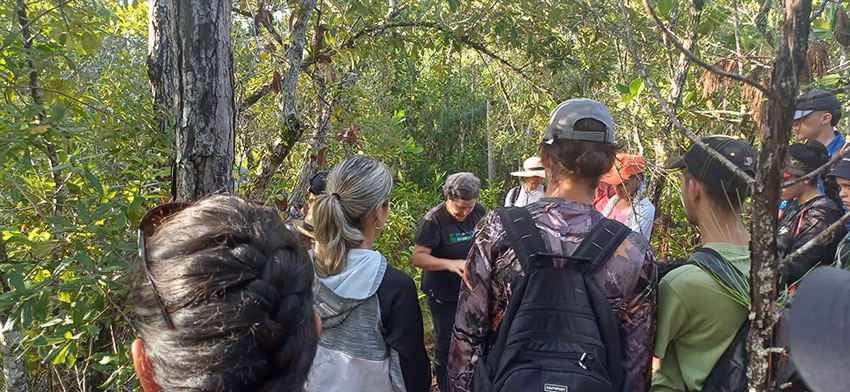CIENPINOS conducted studies of edaphic macrofauna and characterization of botanical composition on farms of acorn-fed swine producers

- Specialists and technicians from the “Indio Hatuey” Experimental Station of Pastures and Forage (EEPFIH), professors from the Viñales Municipal University Center (CUM) and students and professors from the Faculty of Forestry and Agricultural Sciences of the University of Pinar del Río (UPR) participated in the actions.

Viñales, Pinar del Río October 14, 2024. Days marked by the constant presence of rains and intense sunshine, long journeys and intricate roads characterized the CIENPINOS work days, as part of the studies of the edaphic macrofauna (i.e., that inhabit the soil) in the 5 regions or specific areas that constitute project scenarios in the municipality of Viñales, in the province of Pinar del Río, Cuba.
Dr. Mildrey Soca Pérez, leader of the Training Component within the national direction of CIENPINOS, with experience in the application of methodologies for the study of soil macrofauna, headed a team of experienced technicians responsible for implementing the procedure with great meticulousness. “With these studies, CIENPINOS will offer a scientific response to the diversity of criteria on the impact that Pinar del Río Creole pig breeding can have on these ecosystems, hence the importance of the research,” he said.
The selected methodology is in accordance with the extensive grazing system for raising the Pinar del Pinar Creole pig and takes into account the characteristics of the species, which, in addition to consuming acorns from the oak tree, other fruits from the forest and the food that people offer it, is capable of obtaining part of its food needs by foraging (i.e., digging with its snout) in the soil.
Dr. Soca Pérez, head researcher at the Experimental Station of Pastures and Forages “Indio Hatuey” (EEPFIH), added that “the methodology is based on identifying the presence of different species of invertebrates and non-invertebrates in randomly selected quadrants within a plot, evaluating both the leaf litter and the soil layers at different depths. 100% of the organisms found are collected in individual jars with preservative, which are then taken to the laboratory for study”.
This methodology, in spite of having been described some years ago, is still valid today, is simple and easy to apply. Although it has been used to study macrofauna in different ecosystems, there are no antecedents of this type of research under the concrete conditions of acorn pig breeding in Viñales, so this study is the first one with these purposes.
In this first stage of the investigation of the edaphic macrofauna, we will go as far as the identification of the genus, although, if the collection of individuals represents a biological interest for the region, we do not rule out synergies with other scientific institutions that can take the classification to a greater depth.
From the floristic inventory to the collection of valuable information for CIENPINOS
Equipped with a forceps, diametric tape, tape measure and hypsometer, first and second year students of Forestry Engineering, together with their professors, who were linked to CIENPINOS, went deep into the forest to characterize its structure, classify the forest formation and project the afforestation or reforestation of the study area, as part of the floristic inventory.

Forestry engineer Noexis Palacios, professor of the Faculty of Forestry and Agricultural Sciences of the University of Pinar del Río (UPR) highlighted the close link between the academic objective of the students and the purposes of the studies carried out by CIENPINOS. “This exercise links ecology, soil, topography and botany, specifically with the identification of species. It is fundamental to identify how all the strata of the forest, whether herbaceous, shrubs or trees, influence the conformation of the soil macrofauna,” he said.

The inventory is carried out in plots of different dimensions. “The 1 square meter plots are the most important because you can identify the regeneration that exists of each of the botanical species that are in the tree stratum, offering a projection of the number of strata and individuals that will exist in the future, of each of the species that are present here,” explained Palacios.
For the students who participated in the activity, this has been an important experience for their life as a student. “We have been counting each individual of each species and valuing biodiversity together with CIENPINOS and the experience has been very valuable,” said Carlos Manuel Díaz Romero, a first year Forestry Engineering student. “It has been my first experience and I leave very motivated and confident that I will continue to train as a Forestry Engineer,” said his classmate Mario Díaz Cruz. “It allows us to put into practice what we have been taught in the classroom, to see up close, to touch, to have the experience of what we are going to face in the future,” said Luis Alberto Reyes, a second-year student.
During the field trips, the students also delimited each study area and identified its main characteristics. As part of the information collected, sketches of each area were made based on the route taken. The technical information gathered will be evaluated by specialists and will be returned as scientific knowledge in the context of CIENPINOS for decision-making.
The technical-methodological work follows the same procedure in all areas. Both the macrofauna studies and the selection of plots for the identification of the botanical composition by students and professors of the Faculty of Forestry and Agricultural Sciences of the UPR coincide in the operational design.
These activities are a combination of research and training, made possible thanks to the organizational work of the Management Unit of the Municipal University Center (CUM) of Viñales and the joint work of professionals and students.
More information:
Ismael Hernández Venereo
International coordinator
CIENPINOS Project
ismael.hernandez@catie.ac.cr
Written by:
Raúl Isidrón Pichs
Journalist and Communicator
CIENPINOS Project
raul.isidron@73gmail.com



